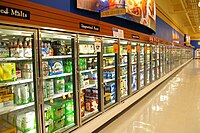
Photo from wikipedia
The main challenge facing adsorption cooling technology is low Coefficient of Performance (COP), which becomes a key factor of the commercialization of this technology. This paper presents the results of… Click to show full abstract
The main challenge facing adsorption cooling technology is low Coefficient of Performance (COP), which becomes a key factor of the commercialization of this technology. This paper presents the results of modifications, aiming to increase COP, applied to the control software of a prototype three-bed two-evaporator adsorption chiller. Changes were mainly related to the sequence of the switching valves and had no influence on the hardware of the chiller. The sequence changes enabled the introduction of heat recovery and mass regeneration. Moreover, the precooling process was improved. The applied modifications not only resulted in significant improvement of the chiller’s COP, but also improved the cooperation adsorption unit heating source, which is of great importance in case of district heating supply. The improvement was also observed concerning such operational aspects as noise and vibrations. In the authors’ opinion, the presented modifications can be introduced to most exploited adsorption chillers and could potentially lead to similar improvements in performance.
Journal Title: Energies
Year Published: 2019
Link to full text (if available)
Share on Social Media: Sign Up to like & get
recommendations!